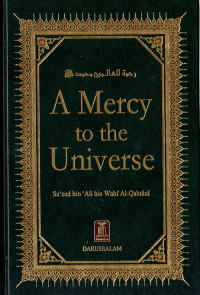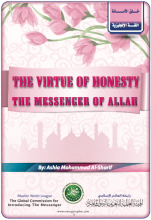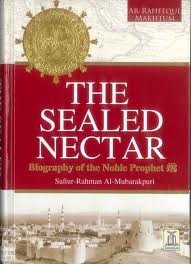The Prophet of Mercy Website
Muslim World League - Global Commission for Introducing the Messenger
Madinah was a veritable oasis. The soil warranted a systematic cultivation and hence, its population was given over to farming and gardening. The main produce of the city consisted of grapes and dates, of which there were numerous groves,(14) trellised and untrellised. Two or more palm-trees occasionally grew out of a single root. (See Quran 141 and 13:4)
Cereals and vegetables of different varieties were cultivated in the farms but the date palm remained the chief item on the menu of the people, especially in times of drought, for the fruit could be stored for sale or exchanged with other necessities. The date palm was the queen of Arabian trees, the source of prosperity concerning the people of Madinah, providing them with solid food and fodder for the camels. Its stems, barks and leaves were also utilized in the construction of houses and manufacture of other goods for daily use. (15)
Countless varieties of date palm (16) were grown in Madinah where the people had evolved, through experience and experimentation, methods to improve the quality and production of dates. Among these was the distinction made between the male pollens and female pistils of date palms and the fertilization of ovules which was known as Tabir.(17)
Madinah was a leading agricultural center, it had also a flourishing mercantile business though not of the same magnitude as that of Makkah. The barren, rocky valley of Makkah allowed no other occupation save to set out with merchandise caravans regularly during the summer and winter season for their source of livelihood.
Certain industrial pursuits were restricted to the Jews of Madinah. They had probably brought the expertise to Madinah from Yemen as, for instance, Banu Qaynuqaa practiced the trade of goldsmiths. Wealthier than other tribes occupying Madinah, the houses of the Jews were flushed with money and abounding in gold and silver. (Al-Yahud fi Balad il-Arab, p. 128)
The soil of Madinah is excessively fertile because of the volcanic matter that made possible the surrounding lava plains. The town stands at the lower part of the valley where water courses running from the higher altitudes irrigated the agricultural lands and date-palm plantations. A verdant wadi well supplied with water and laden with gardens and vineyards, then known as Aqiq, was the pleasure spot of Madinahs residents. There were many wells scattered all over the town whereby almost every garden had one by which it was irrigated, for underground water was found to be in excess.
The vineyards and date plantations, enclosed by garden walls, were known as hayet. (18) The wells had sweet and plentiful supply of water, which was channeled to the orchards by means of canals or through lift irrigation. (19)
Barley was the main cereal produced in Madinah with wheat as the second one, but vegetables were grown in abundance. Transactions of different types (20) like Muzababa (21), Muhaqala, (22) Mukhabra (23), Muawama, (24) etc. were in vogue, some of which were retained by Islam while others were modified or forbidden altogether.
The coins in circulation at Makkah and Madinah were similar to that of the ones mentioned in the section covering Makkah. However, as the inhabitants of Madinah had to transact their business in foodgrains and fruits, they had more of their dealings with measures of capacity. These quantitative measures were Mudd, Sa, Faraq, Araq and Wasaq. The measures of weight prevalent in Madinah were dirham, shihaq, danaq, qirat, naqwat ratl, qintar and auqiya. (25)
Madinah had a fertile soil but it was not self-sufficient in food-grains that it had to import some of the foodstuffs required by it. Flour (26), refined butter and honey were brought from Syria. At-Tirmidhi relates on the authority of Qatada b. Numan that the staple diet of the people of Madinah consisted of dates and barley. But those who were rich used to purchase flour from the Syrian merchants (27) for their own consumption while other members of the family had to contend with dates and barley. (28) This report brings to light the culinary habits as well as the disparity in the standards of living of the well-to-do and the poorer sections of the society in Madinah existing before the migration of the Prophet (peace be upon him).
In their character and disposition, the Jews have remained unchanged in every place and age, bringing to pass almost the same course of human affairs. In Madinah, they constituted the affluent class while the Arab tribesman, like other nave and guileless Bedouins, were not bothered about the future and did not even concern themselves on saving for the rainy days. Apart from that, generosity was in their blood, which manifested itself in selflessly spending for the entertainment of their guests. Naturally enough, they were very often forced to borrow money with interest from the Jews by pledging their personal property.
The livestock raised by the people consisted, for the most part, of camels, cows and ewes. Even then, the camels were also employed for irrigating the agricultural lands wherein they are finally called as Al-Ibil un-Nawadeh when used in such manner. Madinah had several pastures, of which the two, Dhoghabata and Ghaba, were more well-known. Residents of Madinah used to put their flocks for grazing on these pasturelands, while at the same time making such grazing grounds as their source of firewood. They reared horses as well, though not in the same scale as did the inhabitants of Makkah, for military operations. Banu Sulaym were distinguished for their horsemanship although they used to import their horses from other regions.
Madinah had a number of markets, the most important of which was the one conducted by Bani Qaynuqaa which consisted of silver and gold ornaments, clothes and other handiworks, cotton and silk fabrics. Varied carpets and curtains with decorative designs (29) were normally available in this market. Similarly, there were shopkeepers who sold ambergris and quicksilver. (Al-Taratib al-Dariyah, Vol. IV, p. 258)
Numerous forms of business transactions had evolved into practice, some of which were upheld by Islam while others were forbidden. The dealings that had become customary were known as najsh-wa-ahtikar, talaqqi ur-rukban, baI ul-masarrat, baiI nasisah, baI al-hadir lalabadi, baI ul-mujazafah, baI ul-mudhabana and makhadrah. (30)
The social and cultural life of the common people in Madinah was, thanks to their elegant taste, fairly well advanced. Two-storied houses were a common fixture in the Area (31) where some of these had even attached kitchen gardens. The people were used to drinking sweet water, which had to be often conducted from a distance. Cushions (At-Taratib al-Idariyah, Vol. I, p. 97) were used for sitting and the household utensils included bowls and drinking vessels made of stones and glasses. Lamps were manufactured in different designs. (At-Taratib al-Idariyah, Vol. P. 104) Bags and small baskets were used for carrying commodities of daily use as well as corn from the fields. The residences of those who were affluent, particularly the Jews were well-decorated with various other types of furniture. The jewelry worn by the womenfolk were bracelets, armlets, wristlets, earring circlets, rings, golden or gem necklaces, (32) etc.
Spinning and weaving were popular domestic endeavors from which women find solace with in their spare-time at Medina. Sewing and dyeing of clothes, house-building, brick-laying and stone crafts were some of the manual arts already known to the city folks before the Prophet emigrated there.
YATHRIBS ADVANCED AND COMPOSITE SOCIETY
The Hijrah of the Prophet and his companions from Makkah to Madinah was, in no wise, an emigration from a town to any hinterland known by the name of Yathrib but from one city to another. The new home of the migrs was, at the same time different in many respects from the town they had left. For one, it was comparatively smaller from the former but the society was more complex in comparison to the social life of Makkah. The Prophet (peace be upon him) was therefore, expected to come across problems of different scope and nature owing to the subscription of its populace to different religions offering various social codes and customs, not to forget its divergent cultural patterns. The Herculean task ahead of him was one of alleviating and overcoming such prevailing situation. By and large, only a prophet could achieve this feat. One who is commissioned and blest by God with wisdom, foresight, conviction and firmness of purpose and capacity to smother and blend the conflicting ideas and ideals into a new concept, one which could usher the dying humanity into a new brave and commendable world. And, above all, such arbiter or savior had to have a loveable personality. How very aptly has God set forth the services rendered by that benefactor of the human race?
And (as for the believers) hath attuned their hearts. If thou hadst spent all that is in the earth thou couldst not have attuned their hearts, but Allah hath attuned them. Lo! He is Mighty, Wise.
Qur'aan Quran 8:63]
Reference: http://www.pbuh.us
******





